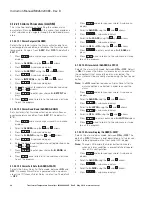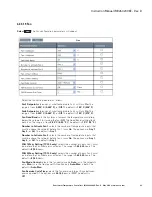
29
Instruction Manual IM02602008E - Rev. D
Transformer Temperature Controllers
IM02602008E - Rev. D May 2019 www.eaton.com
4.1.2.2.16.3 Trend Time Hour Increment Setting (TREND/
HOUR) (TC-100 Only)
Selects the time interval for logging trend data in
HOURS
.
The range is
1-24 HOURS
. The default is
12 HOURS
.
1. Press
Prog
and enter your password. A sub-menu
displays.
2. Scroll to
TREND
using the
and
arrows.
3. Press
Select
. A sub-menu displays.
4. Scroll to
HOURS
using the
and
arrows.
5. Press
Select
.
X HOUR
displays
6. Enter the number of hours desired using the
and
arrows.
7. Press
Select
.
HOUR
displays.
8. Press
Back
once to return to the sub-menu or twice
to exit the program.
4.1.2.2.16.4 Trend Time Day Increment Setting (TREND/DAY)
(TC-100 Only)
Selects the time interval for logging trend data in
DAYS
. The
range is
1-30 DAYS
. The default is
12 DAYS
.
1. Press
Prog
and enter your password. A sub-menu
displays.
2. Scroll to
TREND
using the
and
arrows.
3. Press
Select
. A sub-menu displays.
4. Scroll to
DAY
using the
and
arrows.
5. Press
Select
.
X DAYS
displays.
6. Enter the number of days desired using the
and
arrows.
7. Press
Select
.
DAY
displays.
8. Press
Back
once to return to the sub-menu or twice
to exit the program.
4.1.2.2.17 Discrete Input 1 Selection (D-Input1)
(TC-
100 Only)
This is the top level menu for configuring the use of dis-
crete input 1. The options are
NOT USED
,
FAN FAIL
, and
USER DEF
(user defined). The default is
NOT USED
. When
FAN FAIL
or
USER DEF
is selected further sub-menus are
provided to complete the configuration as shown in the fol-
lowing sections.
4.1.2.2.17.1 Discrete Input 1 Selection (D-INPUT1/NOT
USED) (TC-100 Only)
When selected, this turns off all responses to discrete input
1. This is the default operating condition. To utilize discrete
input 1, configure it as
FAN FAIL
or
USER DEF
as defined
in the following sections.
4.1.2.2.17.2 Discrete Input 1 Fan Fail Selection (D-IPUT1/FAN
FAIL) (TC-100 Only)
Configures discrete input 1 for use as a fan fail detector.
This may be used with an airflow sensor or micro switch
connected to ventilation louvers to indicate when the fan is
operating properly.
When selected, two options are given for the input state
that indicates a fan failure. The options are
OPEN
or
CLOSED
to allow connection to either NC or NO contacts.
The default is
OPEN
.
After the input state is selected two more options are given
for the effect to occur when a fan failure is detected. The
options are
ALM ONLY
(alarm only) or
ALM+FAN2
(alarm
and turn on Fan 2). The default is
ALM ONLY
.
Selecting either option will activate an alarm condition when
a fan failure is detected, activating the alarm relay and front
panel LED, and if enabled, displaying
A. AIR-ND
(airflow not
detected). The second option can be used to configure Fan
2 as a backup to come on if FAN 1 fails.
1. Press
Prog
and enter your password. A sub-menu
displays.
2. Scroll to
D--INPUT 1
using the
and
arrows.
3. Press
Select
. A sub-menu displays.
4. Scroll to
FAN FAIL
using the
and
arrows.
5. Press
Select
. A sub-menu displays.
6. Scroll to
OPEN
or
CLOSED
using the
and
arrows.
7. Press
Select
to enter your selection. A sub-menu
displays.
8. Scroll to
ALM ONLY
or
ALM + FAN 2
using the
and
arrows.
9. Press
Select
to enter your selection.
OPEN
or
CLOSED
displays.
10. Press
Back
once or twice to return to the sub-menus
or three times to exit the program.
4.1.2.2.17.3 Discrete Input 1 User Defined (D-IPUT1/USER
DEF) (TC-100 Only)
Configures discrete input 1 as a user defined function.
This may be used with a wider array of external sensors or
switches to generate an alarm or trip condition, control the
fans, or even control other equipment using the Fan2 relay.
When selected, two options are given to define the relation-
ship between the input state and output state. The options
are
DIRECT
, which means a closure on the input results in
a closure on the output, or
INVERT
which means an open
on the input causes a closure on the output. This allows
the use of NO or NC contacts on the input. The default is
DIRECT
.






























